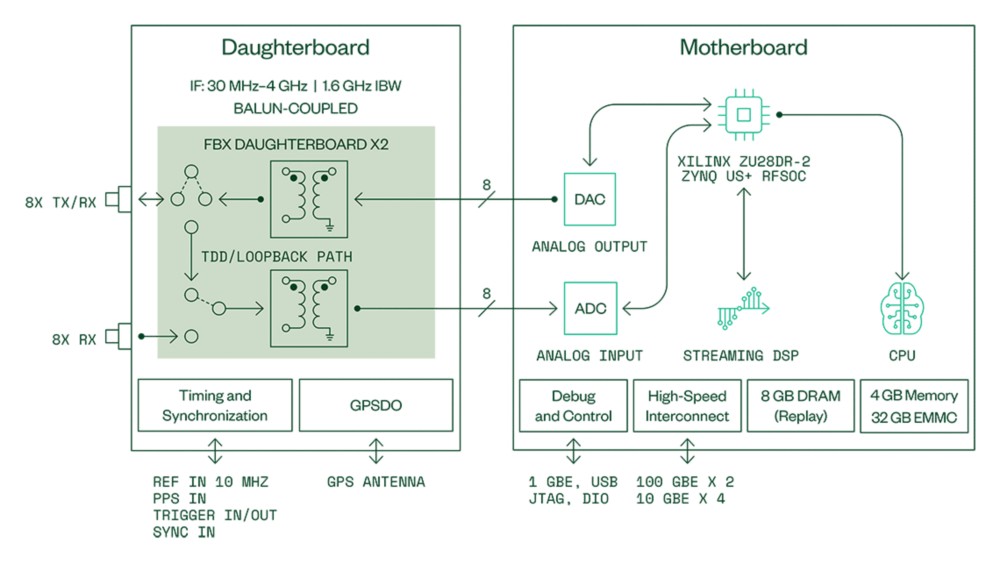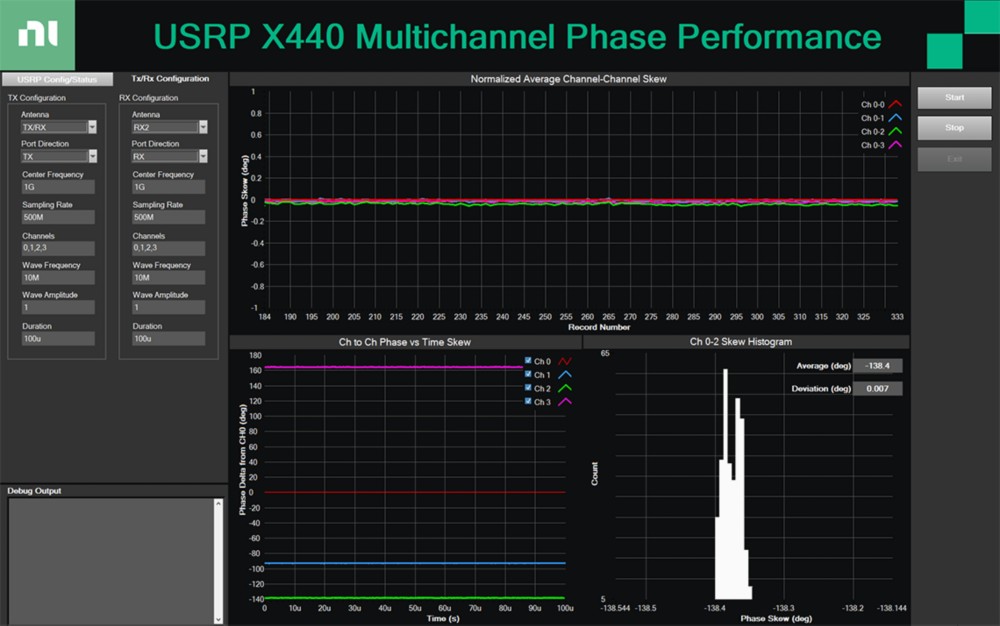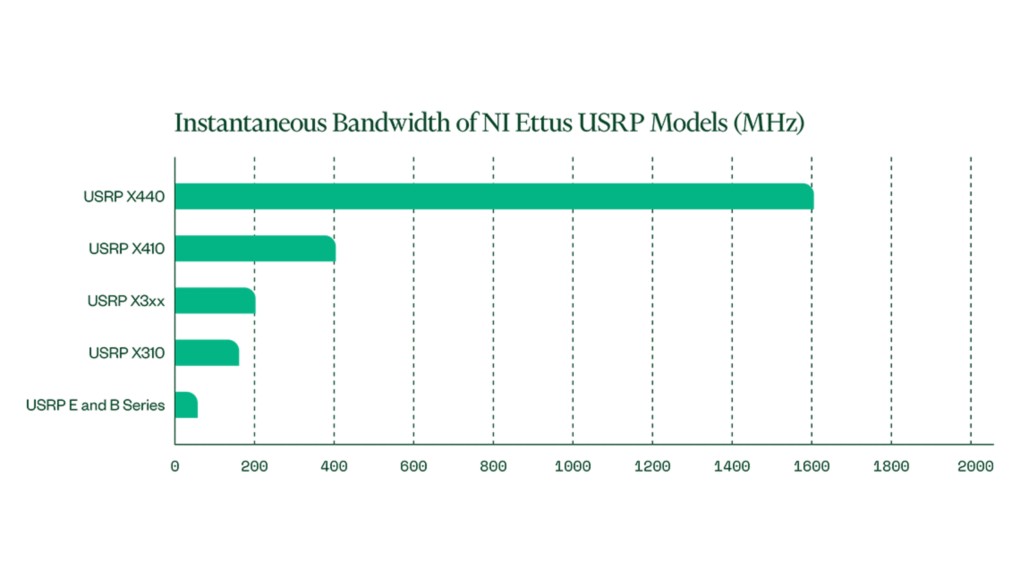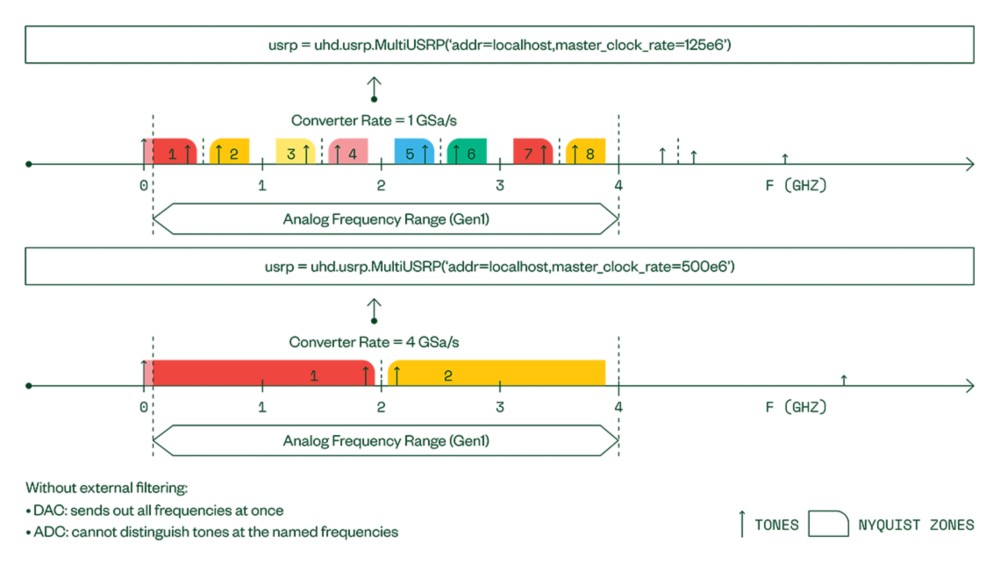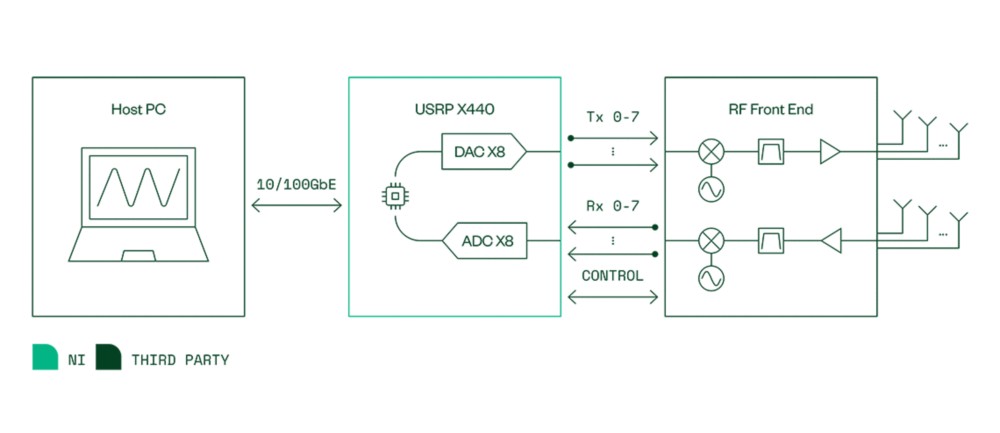Prototyping Radar and EW Systems with the Ettus USRP X440
Overview
Whether for ensuring the survivability of friendly platforms or for disrupting an adversary’s use of the spectrum, dominance of the electromagnetic (EM) spectrum is a major contributor to mission success. Electromagnetic spectrum operations (EMSO) require tactical systems that can monitor the spectral activity of an adversary, locate emitters, and help friendly forces to formulate a plan of action. Software defined radios (SDRs) provide the flexibility needed to assess the performance of new EM techniques, and the Ettus USRP X440 SDR was developed with aerospace and defense requirements, including phase coherency and wide bandwidth, in mind.
Contents
- Challenges for Modern EM Systems
- Phase Coherency for Beamforming and Direction Finding
- Wideband Generation and Acquisition
- Frequency and Sample Rate Planning
- Next Steps
Challenges for Modern EM Systems
The electromagnetic spectrum is simultaneously vast and crowded. With billions of connected devices operating globally, these devices—whether commercial or military—are vying for the use of the spectrum. This competition necessitates the expansion of communications devices into higher frequency portions of the spectrum to provide appropriate bandwidth for devices to operate. While this is beneficial to the devices using the spectrum, it broadens the search area for the signals intelligence receivers that are aiming to maximize the probability of intercepting signals of interest. Tracking the full usable frequency range is challenging, requiring either multiple radios or wideband receivers to cover the plethora of frequency options available to connected devices.
Whether for introducing wider bandwidth systems, cognitive techniques, fully digital beamforming, or any novel capability, functions must be appropriately assessed and validated, likely in software simulation and with real hardware, prior to transferring to fielded deployment. Software defined radios (SDRs) help to bridge the gap from lab-based experimentation to tactical use.
The Ettus USRP X440 software defined radio has an architecture unlike other USRP devices. The Ettus USRP X440 has a balun-coupled, direct-sampling architecture that provides access to the DACs and ADCs on the onboard Xilinx Zynq RFSoC. It may be used to directly sample frequencies up to 4 GHz, or it may be connected to external front ends for extending to higher frequency coverage. These front ends could be optimized for applications like satellite communications (SATCOM) prototyping, SATCOM ground station deployment, or mmWave and sub-THz 6G research.
Figure 1: Block Diagram of the Ettus USRP X440 Software Defined Radio Device
Without RF circuitry in the device, space is saved, allowing more channels to be incorporated without increasing footprint. The Ettus USRP X440 SDR features 8 TX and 8 RX channels per device. These channels can be made phase coherent by sharing the sample clocks, making the X440 ideal for applications like direction finding and radar research and prototyping.
Phase Coherency for Beamforming and Direction Finding
The International Telecommunication Union (ITU) defines direction finding accuracy as “the RMS (root mean square) value of the difference between the true azimuth and the displayed bearing.” Achieving that accuracy with SDR (or any) hardware relies on tight synchronization and minimal phase skew across channels. Within a single Ettus USRP X440 device, typical RX phase stability is <0.1° RMS. Even when synchronizing channels across multiple devices, the RX phase stability remains <1° RMS. This stability provides exceptional accuracy for direction finding. If beamforming is required, the TX phase stability is <0.5° RMS within an Ettus USRP X440 device, and <1° RMS from device to device. Refer to the Ettus USRP X440 device specifications for the complete list of values by master clock rate and for measurement methodology.
Figure 2: The Ettus USRP X440 offers minimal phase skew from channel to channel, for beamforming and direction finding.
Wideband Generation and Acquisition
As previously mentioned, wideband technology is an important factor in detecting and recording adversarial signals, but it also has great benefits for the effectiveness of friendly systems. For example, radar systems with wider bandwidths can achieve higher resolution, allowing them to detect smaller objects or distinguish between closely spaced objects. This capability, in turn, improves the ability to identify and classify targets, reducing the risk of misclassification and improving the accuracy of targeting. Wider bandwidth systems also are typically more frequency agile, capable of hopping between operating frequencies without retuning. These systems are harder to detect and monitor but also harder to jam or disrupt.
Prototyping wideband capabilities in the lab requires software defined radio hardware with appropriate wide bandwidth itself. The Xilinx RFSoC onboard the Ettus USRP X440 is capable of sampling at 4 GSps, providing an aggregated 3.2 GHz of instantaneous bandwidth across the device. This bandwidth can be allocated at up to 1.6 GHz per channel for a 1- or 2-channel implementation or at up to 400 MHz per channel for eight channels. This bandwidth is a significant increase compared to previous USRP models, making the X440 especially well suited to wideband radar and EW applications.
Figure 3: The Ettus USRP X440 extends instantaneous bandwidth significantly beyond prior USRP models.
Frequency and Sample Rate Planning
For bands below 4 GHz—S band, L band, and the HF/VHF/UHF bands—USRP X440 may be used to directly sample the spectrum. The architecture of the Ettus USRP X440 allows the full bandwidth of the Xilinx RFSoC to be harnessed. However, since there is no built-in IF signal conditioning, a degree of frequency planning is required to avoid effects that may distort the signal of interest. The Ettus X440 USRP may sample at frequencies greater than the Nyquist frequency, defined as half the ADC converter sampling rate (Fs). Unfortunately, this method introduces aliasing effects, where unwanted signals appear as mirror images around multiples of the Nyquist frequency (Fs/2). It creates an unusable frequency range around each Nyquist zone boundary, so careful planning must be executed to avoid signals of interest spanning multiple Nyquist zones, which would result in distorted signals of interest or interfering signals being aliased into the measured spectrum.
Figure 4: Master clock rates must be selected carefully to avoid Nyquist zone boundaries from interfering with signals of interest.
For more depth on frequency planning and master clock rate selection with X440, visit https://kb.ettus.com/About_Sampling_Rates_and_Master_Clock_Rates_for_the_USRP_X440.
Radar systems frequently use bands above the 4 GHz coverage offered natively by the Ettus USRP X440. For example, many weather, surveillance, air traffic control, and defense tracking radars operate at C band, X band, and beyond. Despite the frequency limitations, Ettus USRP X440 devices are well suited to act as intermediate frequency (IF) transceivers, linking with external RF front ends to handle upconversion and downconversion to and from the frequencies of interest. Care should be taken to select front ends that will accept and provide IFs at <4 GHz, so that they may be sampled by an Ettus USRP X440. The front ends should also accept a digital control signal, which can be supplied from the DIO port on the front panel of the X440 device. The USRP Hardware Driver (UHD) uses an extension framework that allows the USRP to control an external front end via the UHD API. To learn more about the extension framework, visit https://files.ettus.com/manual/page_extension.html.
Figure 5: Ettus USRP X440 is ideal for pairing with external upconverters and downconverters to address higher frequency bands.
Researchers and systems engineers designing novel capabilities for aerospace and defense systems require flexible, reconfigurable hardware that allows concepts to be tested with minimal hardware changes. The Ettus USRP X440 was designed not only to address these needs but also to meet wide bandwidth requirements for spectrum monitoring and high-resolution radar, as well as to provide multichannel phase coherency for direction finding or beam steering.
Watch a demonstration of the Ettus USRP X440 in the following video.
